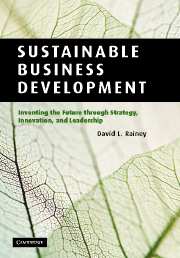Book contents
- Frontmatter
- Contents
- List of figures
- List of tables
- List of boxes
- List of abbreviations
- Acknowledgments
- Introduction
- Part I Enterprise thinking, the driving forces of change, and leadership
- 1 Sustainable business development: overview and guiding principles
- 2 Enterprise thinking and the strategic logic of strategic business development
- 3 Crafting sustainable business strategies and solutions
- 4 The driving forces of social-, economic-, and environmental-related change
- 5 The driving forces of markets and stakeholders' connectedness
- 6 Crafting a sustainable enterprise through leadership and capabilities
- Part II Innovation management, life cycle considerations, and insights
- Glossary
- Select bibliography
- Index
- References
5 - The driving forces of markets and stakeholders' connectedness
from Part I - Enterprise thinking, the driving forces of change, and leadership
Published online by Cambridge University Press: 04 December 2009
- Frontmatter
- Contents
- List of figures
- List of tables
- List of boxes
- List of abbreviations
- Acknowledgments
- Introduction
- Part I Enterprise thinking, the driving forces of change, and leadership
- 1 Sustainable business development: overview and guiding principles
- 2 Enterprise thinking and the strategic logic of strategic business development
- 3 Crafting sustainable business strategies and solutions
- 4 The driving forces of social-, economic-, and environmental-related change
- 5 The driving forces of markets and stakeholders' connectedness
- 6 Crafting a sustainable enterprise through leadership and capabilities
- Part II Innovation management, life cycle considerations, and insights
- Glossary
- Select bibliography
- Index
- References
Summary
Introduction
Throughout the 1990s, customer satisfaction reigned supreme in the mindset of corporate executives, managers, and marketing professionals as they tried to differentiate their products and improve corporate performance. While customer satisfaction remains critical for realizing positive outcomes today, it is a subset of the more inclusive view of total satisfaction that also includes meeting broader stakeholder expectations and societal needs. Total satisfaction necessitates solutions that include social, economic, and environmental considerations. Great solutions are balanced from every perspective: they exceed needs, create exceptional value, and satisfy expectations.
With the dramatic expansion of information and knowledge provided through the Internet and world-wide media, customers and stakeholders are empowered with facts, figures, and specifications about products and processes that would have been impossible to obtain a decade ago. In many situations, customers know as much about the products they buy as do the individuals selling them. They can scrutinize the competitive landscape to find the right product at the right price. Moreover, customers and stakeholders can share their opinions and perceptions with thousands of others who are interested in the veracity and accuracy of product claims, advertising messages, process outcomes, waste problems, and any negative impacts associated with production and use. It is becoming more difficult to espouse only positive attributes using glossy marketing campaigns or fancy promotions, or to mislead people through false impressions.
- Type
- Chapter
- Information
- Sustainable Business DevelopmentInventing the Future Through Strategy, Innovation, and Leadership, pp. 270 - 335Publisher: Cambridge University PressPrint publication year: 2006



